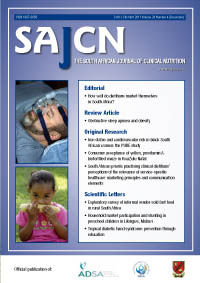Obstructive sleep apnoea and obesity
Keywords:
obstructive sleep apnoea, obesity
Abstract
The global obesity epidemic continues to gain momentum, and South Africa is one of those countries with an extremely high prevalence of obesity. The reported association between obstructive sleep apnoea (OSA) and obesity has resulted in a parallel increase in the incidence of OSA. Obesity and OSA interact by inducing systemic inflammation, metabolic aberrations and endocrine abnormalities, all of which predispose patients to atherosclerosis and cardiovascular disease. OSA is associated with a pro-inflammatory state, and increased serum C-reactive protein concentrations. Cardiovascular complications of OSA include myocardial infarction, stroke, congestive heart failure, hypertension and cardiac arrhythmias. The complications of OSA and obesity result in reduced quality of life, significant morbidity, and increased mortality, for untreated patients. OSA causes symptoms such as snoring, apnoea, excessive daytime sleepiness, and morning headaches, but 80-90% of patients are never diagnosed, or treated for their condition. Recognition of these symptoms, and referral of patients for a polysomnogram (home- or laboratory-based), expedites the diagnosis and therapy of OSA. While continuous positive airway pressure (CPAP) remains the mainstay of therapy, dietary measures are important, and should be implemented. Loss of weight can lead to significant reductions in the apnoea-hypopnoea index (AHI) of patients with OSA, and obese patients with OSA should aim for a 10% reduction in body weight.
How to Cite
Tintinger, G., Pretorius, L., & Labadarios, D. (1). Obstructive sleep apnoea and obesity. South African Journal of Clinical Nutrition, 24(4), 174-177. Retrieved from http://sajcn.co.za/index.php/SAJCN/article/view/605
Issue
Section
Review Articles
Material submitted for publication in the South African Journal of Clinical Nutrition (SAJCN) is accepted provided it has not been published elsewhere. Copyright forms will be sent with acknowledgement of receipt and the SAJCN reserves copyright of the material published.
The SAJCN does not hold itself responsible for statements made by the authors.


